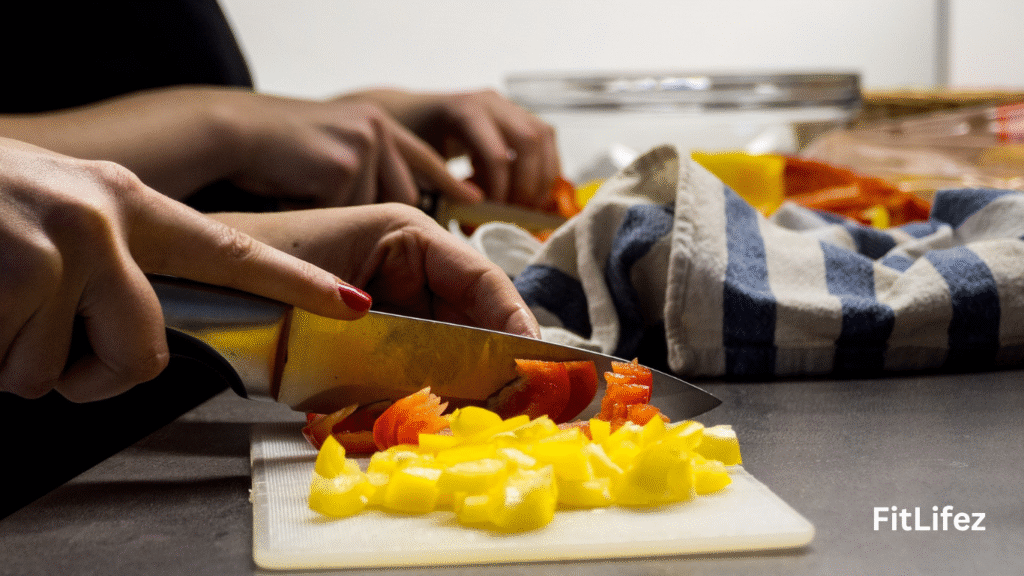Introduction
Hello, I’m Muhammad Shakeel, a seasoned article writer with five years of experience in creating engaging and informative content. On my website, [FitLifez), I focus on providing readers with valuable information on health and wellness.
Today, I want to share with you some delightful and nutritious Asian recipes that not only satisfy your taste buds but also contribute to a healthier lifestyle.
Asian cuisine is renowned for its bold flavors, vibrant colors, and the use of fresh ingredients. It emphasizes balance and harmony, not just in taste but also in nutritional value. By incorporating more Asian dishes into your diet, you can enjoy a diverse range of flavors while benefiting from the wholesome, nutrient-rich ingredients commonly used in these recipes.
The Principles of Healthy Asian Cooking
Before diving into the recipes, it’s essential to understand the principles of healthy Asian cooking. Asian cuisine generally emphasizes:
1. Fresh Ingredients: Vegetables, lean proteins, and herbs are staples, ensuring meals are rich in essential nutrients.
2. Balanced Flavors: Dishes often balance sweet, sour, salty, and bitter flavors, which can help reduce the need for excessive seasoning or sauces.
3. Mindful Portion Sizes: Meals are typically served in smaller portions, encouraging mindful eating and better digestion.
4. Cooking Methods: Techniques such as steaming, stir-frying, and grilling help retain the nutritional content of ingredients.
5. Herbs and Spices: Instead of heavy creams or sauces, Asian dishes use herbs and spices to enhance flavors, which can also provide health benefits.
Recipe 1: Vietnamese Pho
Pho is a Vietnamese noodle soup that is both comforting and nourishing. It’s typically made with a clear broth, rice noodles, herbs, and meat, usually beef or chicken. Here’s a healthy version of this classic dish:
Ingredients
– 8 cups chicken or beef broth (preferably homemade)
– 1 onion, halved
– 3-inch piece of ginger, sliced
– 2 cloves garlic, smashed
– 1 cinnamon stick
– 2 star anise
– 3 cloves
– 1 tablespoon fish sauce
– 1 tablespoon soy sauce (low sodium)
– 8 ounces rice noodles
– 2 cups cooked chicken breast or lean beef, thinly sliced
– Fresh herbs: cilantro, basil, mint
– Bean sprouts
– Lime wedges
– Sliced chili peppers (optional)
Instructions
1. Prepare the Broth: In a large pot, combine the broth, onion, ginger, garlic, cinnamon stick, star anise, and cloves. Bring to a boil, then reduce the heat and let it simmer for about 30 minutes. Strain the broth, discarding solids. Stir in the fish sauce and soy sauce.
2. Cook the Noodles: Cook the rice noodles according to the package instructions. Drain and set aside.
3. Assemble the Pho: Divide the noodles among serving bowls. Top with sliced chicken or beef. Pour the hot broth over the top.
4. Garnish: Serve with fresh herbs, bean sprouts, lime wedges, and sliced chili peppers.
Nutritional Benefits
Pho is low in fat and high in protein, especially when using lean meats. The broth is rich in collagen if made from bones, which is great for joint health. Fresh herbs provide antioxidants and essential vitamins.
Recipe 2: Thai Green Curry with Vegetables
Thai green curry is a flavorful and aromatic dish that is both satisfying and healthy. This version is packed with vegetables, making it a nutritious option for any meal.
Ingredients
– 1 tablespoon coconut oil
– 2 tablespoons green curry paste
– 1 can (14 ounces) coconut milk (light version)
– 1 cup vegetable broth
– 1 cup broccoli florets
– 1 cup sliced bell peppers
– 1 cup sliced zucchini
– 1 cup snap peas
– 1 block firm tofu, cubed
– 1 tablespoon soy sauce (low sodium)
– 1 tablespoon lime juice
– Fresh basil leaves for garnish
Instructions
1. Cook the Curry Paste: In a large pan, heat the coconut oil over medium heat. Add the green curry paste and cook for a minute until fragrant.
2. Add Liquids: Stir in the coconut milk and vegetable broth, bringing the mixture to a simmer.
3. Add Vegetables and Tofu: Add the broccoli, bell peppers, zucchini, and snap peas. Simmer for about 10 minutes until the vegetables are tender. Stir in the tofu, soy sauce, and lime juice.
4. Serve: Garnish with fresh basil leaves and serve with steamed jasmine rice or quinoa for a healthier option.
Nutritional Benefits
This Thai green curry is rich in vitamins and minerals from the variety of vegetables. The use of tofu provides a good source of plant-based protein, and the light coconut milk reduces the overall calorie content without sacrificing flavor.
Recipe 3: Japanese Miso Soup with Tofu and Seaweed

Miso soup is a staple in Japanese cuisine, known for its soothing qualities and health benefits. It’s simple to make and can be enjoyed as a starter or a light meal.
Ingredients
– 4 cups dashi broth (can be substituted with vegetable broth)
– 3 tablespoons miso paste
– 1/2 cup tofu, cut into small cubes
– 1/4 cup dried wakame seaweed
– 2 green onions, thinly sliced
Instructions
1. Prepare the Broth: In a pot, bring the dashi broth to a gentle simmer.
2. Add Miso: In a small bowl, mix a bit of the warm broth with the miso paste to dissolve it. Add the miso mixture back into the pot.
3. Add Tofu and Seaweed: Stir in the tofu and wakame seaweed. Cook for a few minutes until the seaweed is rehydrated and the tofu is heated through.
4. Serve: Garnish with sliced green onions before serving.
Nutritional Benefits
Miso is fermented, offering beneficial probiotics that promote gut health. The soup is low in calories and provides protein from tofu and essential minerals from seaweed.
Recipe 4: Korean Bibimbap
Bibimbap is a traditional Korean dish meaning “mixed rice.” It’s a colorful and nutritious meal that includes a variety of vegetables and protein sources.
Ingredients
– 2 cups cooked brown rice
– 1 cup spinach, blanched
– 1 cup carrots, julienned
– 1 cup bean sprouts, blanched
– 1 zucchini, julienned
– 1 cup shiitake mushrooms, sliced
– 1 tablespoon sesame oil
– 2 eggs
– 1 tablespoon soy sauce (low sodium)
– 1 tablespoon gochujang (Korean chili paste)
– Sesame seeds for garnish
Instructions
1. Prepare Vegetables: In a pan, sauté the carrots, zucchini, and mushrooms separately in a little sesame oil until tender. Set aside.
2. Fry the Eggs: In the same pan, fry the eggs sunny-side up.
3. Assemble the Bibimbap: Divide the rice into bowls. Arrange the spinach, carrots, bean sprouts, zucchini, and mushrooms on top. Place the fried egg in the center.
4. Serve: Drizzle with soy sauce and gochujang. Garnish with sesame seeds before serving.
Nutritional Benefits
Bibimbap is a balanced meal with carbohydrates from rice, protein from eggs, and a variety of vitamins and minerals from the assorted vegetables. The use of brown rice adds fiber, aiding in digestion and maintaining stable blood sugar levels.
Recipe 5: Chinese Steamed Fish with Ginger and Scallions
Steamed fish is a delicacy in Chinese cuisine, known for its simplicity and clean flavors. This method preserves the fish’s nutrients and is a heart-healthy option.
Ingredients
– 1 whole white fish (such as sea bass or tilapia), cleaned and scaled
– 2 inches ginger, julienned
– 4 scallions, sliced
– 2 tablespoons soy sauce (low sodium)
– 1 tablespoon sesame oil
– Fresh cilantro for garnish
Instructions
1. Prepare the Fish: Place the fish on a heatproof plate. Scatter ginger and half of the scallions over the fish.
2. Steam the Fish: Set up a steaming apparatus or use a large pot with a steamer rack. Steam the fish for about 10-15 minutes, or until the flesh is opaque and flakes easily.
3. Final Touches: In a small pan, heat the sesame oil until hot. Carefully pour over the steamed fish. Drizzle with soy sauce and garnish with the remaining scallions and cilantro.
Nutritional Benefits
Steamed fish is low in calories and high in omega-3 fatty acids, which are beneficial for heart health. Ginger adds anti-inflammatory properties, and scallions provide vitamins A and C.
Conclusion
Incorporating healthy Asian recipes into your meal plan is a fantastic way to enjoy delicious and nutritious dishes. These recipes highlight the diverse flavors and health benefits of Asian cuisine, making them perfect for those looking to maintain a healthy lifestyle without sacrificing taste.
Remember, the key to healthy eating is balance and variety, and Asian dishes offer plenty of both. For more health-related tips and recipes, be sure to visit my website, [FitLifez], where you can explore a wealth of information dedicated to helping you lead a healthier, more fulfilling life.
Happy cooking!

